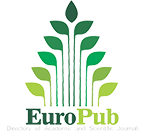Density function theory on the electronic structure property of anatase TiO2 doped by N or C with different percents
Article ID: 1355
Vol 4, Issue 2, 2021
Vol 4, Issue 2, 2021
VIEWS - 5337 (Abstract)
Abstract
Formation energy, crystal structure and electronic structure of C, N doped anatase TiO2 are calculated based on the density functional theory of plane-wave ultrasoft pseudopotential. Results indicate that, due to doping of the C or N atoms in anatase TiO2, the lattice distorts obviously. The substitution of C tends to Ti site while N tends to O site. All the substitutions lead to the red shift of the optical absorption and increasing coefficient of light absorption. When N concentrations are 2.08% and 3.13% in N-doped TiO2, the highest photocatalytic activity is obtained, while it is 2.08% for C-doped one.
Keywords
Anatase TiO2; DFT; N-doped; C-doped; Formation Energy
Full Text:
PDFReferences
- Fujishima A, Honda K. Electrochemical photolysis of water at a semiconductor electrode. Nature 1972; 238: 37–39.
- Gole JL, Stout JD, C Burda C, et al. Highly efficient formation of visible light tunable TiO2−xNx photocatalysts and their transformation at the nanoscale. The Journal of Physical Chemistry B 2004; 108(4): 1230–1240.
- Linsebigler AL, Lu G, Yates JT Jr. Photocatalysis on TiO2 surfaces: Principles, mechanisms, and selected results. Chemical Reviews 1995; 95(3): 735–758.
- Fujishima A, Rao TN, Tryk DA. Titanium dioxide photocatalysis. Journal of Photochemistry and Photobiology C: Photochemistry Reviews 2000; 1(1): 1–21.
- Asahit R, Morikawa T, Ohwaki T, et al. Visible-light photocatalysis in nitrogen-doped titanium oxides. Science 2001; 293(5528): 269–271.
- Cheng G, Zhou X, Li Y, et al. La3+ modification of ZnO-TiO2 coupled semiconductors and their photocatalytic activity. Chinese Journal of Catalysis 2007; 28(10): 885–889.
- Li Z, Wang X, Jia L. Synergistic effects in Fe/N codoped anatase TiO2 (101) surface: A theoretical study based on density functional theory calculation. Acta Physica Sinica 2013; (20): 1–5.
- Hou Q, Zhang Z, Li C. First-principles study of the electronic life and red shift effect of Sm-doped anatase TiO2. Journal of Functional Materials 2012; 43(19): 2599–2604.
- Subrahmanyam A, Biju KP, Rajesh P, et al. Surface modification of sol gel TiO2 surface with sputtered metallic silver for Sun light photocatalytic activity: Initial studies. Solar Energy Materials and Solar Cells 2012; 101: 241–248.
- Li Z, Wang X. First-principle study of electronic structure and enhanced visible-light photocatalytic activity of anatase TiO2 through C and F codoping. Advanced Materials Research 2013; 746: 400–405.
- Zhang MY, He GZ, Ding CC, et al. Mechanism of arsenate (V) adsorption on TiO2 surfaces. Acta Physico-Chimica Sinica 2009; 25: 2034–2038.
- Zheng S, Wu G, Liu L. First-principles calculations of P-doped anatase TiO2. Acta Physica Sinica 2013; (4): 94–100.
- Carp O, Huisman CL, Reller A. Photoinduced reactivity of titanium dioxide. Progress in Solid State Chemistry 2004; 32(1-2): 33–177.
- Suda Y, Kawasaki H, Ueda T, et al. Preparation of high quality nitrogen doped TiO2 thin film as a photocatalyst using a pulsed laser deposition method. Thin Solid Films 204; 453: 162–166.
- Umebayashi T, Yamaki T, Itoh H. Band gap narrowing of titanium dioxide by sulfur doping. Applied Physics Letters 2002; 81: 454–456.
- Cui X, Ma M, Zhang W. Nitrogen-doped TiO2 from TiN and its visible light photoelectrochemical properties. Electrochemistry Communications 2008; 10 (3): 367–371.
- Liu S, Chen X, Li X. Effect of N-doping on structure characteristics and photocatalytic activity of TiO2 photocatalyst. Chinese Journal of Inorganic Chemistry 2008; 24(2): 253–259.
- Khan SUM, Al-Shahry M, Ingler WB Jr. Efficient photochemical water splitting by a chemically modified n-TiO2. Science 2002; 297(5590): 2243–2245.
- Sakthivel S, Kisch H. Daylight photocatalysis by carbon-modified titanium dioxide. Angewandte Chemie International Edition 2003; 42(40): 4908–4911.
- Chen X, Burda C. The electronic origin of the visible-light absorption properties of C-, N- and S-doped TiO2 nanomaterials. Journal of the American Chemical Society 2008; 130(15): 5018–5019.
- Monkhorst HJ, Pack JD. Special points for Brillouin-zone integrations. Physical Review B 1976; 13: 5188–5192.
- Dudarev SL, Botton GA, Savrasov SY, et al. Electron-energy-loss spectra and the structural stability of nickel oxide: An LSDA + U study. Physical Review B 1998; 57: 1505–1509.
- Kavan L, Grätzel M, Gilbert SE, et al. Electrochemical and photoelectrochemical investigation of single-crystal anatase. Journal of the American Chemical Society 1996; 118(28): 6716–6723.
- Jia L, Wu C, Li Y, et al. Enhanced visible-light photocatalytic activity of anatase TiO2 through N and S codoping. Applied Physics Letters 2011; 98(21): 211903–211905.
- Kressea G, Furthmüller J. Efficiency of ab-initio total energy calculations for metals and semiconductors using a plane-wave basis set. Physical Review B 1996; 54(16): 11169–11186.
- Perdew JP, Burke K, Ernzerhof M. Generalized gradient approximation made simple. Physical Review Letters 1996; 77: 3865–3868.
- Zhang X, Cui X. Preparation and photocatalytic hydrogen evolution performance of C-N Co-doped Nano TiO2 photocatalysts. Acta Physico-Chimica Sinica 2009; 25(9): 1829–1834.
DOI: https://doi.org/10.24294/ace.v4i2.1355
Refbacks
- There are currently no refbacks.

This work is licensed under a Creative Commons Attribution-NonCommercial 4.0 International License.









